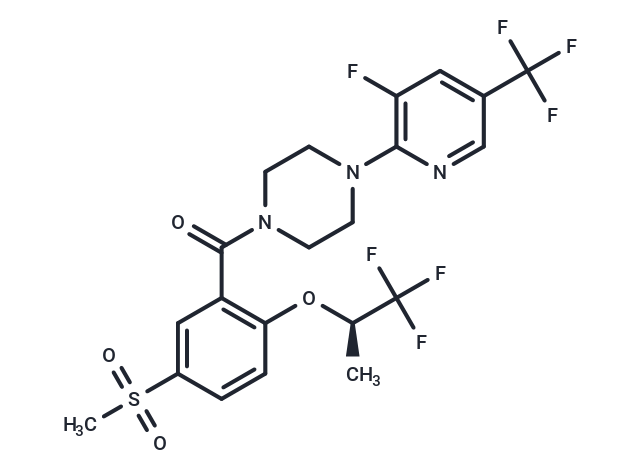Shopping Cart
- Remove All
 Your shopping cart is currently empty
Your shopping cart is currently empty

Bitopertin R enantiomer (RG1678 R enantiomer) is the R-enantiomer of Bitopertin, a noncompetitive glycine reuptake inhibitor that inhibits glycine uptake at human GlyT1 (IC50: 25 nM).

| Pack Size | Price | Availability | Quantity |
|---|---|---|---|
| 25 mg | Inquiry | 6-8 weeks | |
| 50 mg | Inquiry | 6-8 weeks | |
| 100 mg | Inquiry | 6-8 weeks |
| Description | Bitopertin R enantiomer (RG1678 R enantiomer) is the R-enantiomer of Bitopertin, a noncompetitive glycine reuptake inhibitor that inhibits glycine uptake at human GlyT1 (IC50: 25 nM). |
| Targets&IC50 | GlyT1:25 nM |
| In vitro | Bitopertin (RG1678) competitively blocks [3H]ORG24598 binding sites at human GlyT1b in membranes from Chinese hamster ovary cells. In cells stably expressing hGlyT1b and mGlyT1b, Bitopertin potently inhibits [3H]glycine uptake (IC50s: 25 nM and 22 nM). Conversely, Bitopertin has no effect on hGlyT2-mediated glycine uptake up to 30 μM concentration. Bitopertin has a high affinity for the recombinant hGlyT1b transporter. Under equilibrium conditions (1 h at room temperature), Bitopertin displaces [3H]ORG24598 binding (Ki: 8.1 nM). In hippocampal CA1 pyramidal cells, Bitopertin enhances NMDA-dependent long-term potentiation at 100 nM but not at 300 nM [1]. Bitopertin has an excellent selectivity profile against the GlyT2 isoform (IC50>30 μM) and toward a panel of 86 targets including transmembrane and soluble receptors, enzymes, ion channels, and monoamine transporters (<41% inhibition at 10 μM is measured for all targets) [2]. |
| In vivo | Bitopertin dose-dependently increases cerebrospinal fluid (CSF) and striatal glycine levels measured by microdialysis in rats, attenuates hyperlocomotion induced by D-amphetamine or NMDA receptor glycine site antagonist L-687,414 in mice, and prevents hyper-response to D-amphetamine in rats chronically treated with phencyclidine. Vehicle administration has no effect on extracellular striatal glycine levels. Oral administration of Bitopertin (1-30 mg/kg) dose-dependently increases extracellular glycine levels, with a 30 mg/kg dose resulting in a 2.5-fold increase. Similar dose-dependent increases in CSF glycine concentration are observed in rats treated with Bitopertin (1-10 mg/kg) compared to vehicle-treated animals, 3 hours post-administration [1]. In vivo pharmacokinetic studies reveal that Bitopertin has low plasma clearance, intermediate volume of distribution, good oral bioavailability (78% in rats, 56% in monkeys), favorable terminal half-life (5.8 h in rats, 6.4 h in monkeys), high plasma protein binding (97% in preclinical species, 98% in humans), and better CNS penetration in rats (brain/plasma=0.7) than in mice (brain/plasma=0.5) [2]. |
| Alias | RO4917838 (R enantiomer), RG1678 (R enantiomer), Bitopertin R enantiomer |
| Molecular Weight | 543.46 |
| Formula | C21H20F7N3O4S |
| Cas No. | 845614-12-2 |
| Relative Density. | 1.444 g/cm3 (Predicted) |
| Storage | Powder: -20°C for 3 years | In solvent: -80°C for 1 year | Shipping with blue ice. |

Copyright © 2015-2025 TargetMol Chemicals Inc. All Rights Reserved.